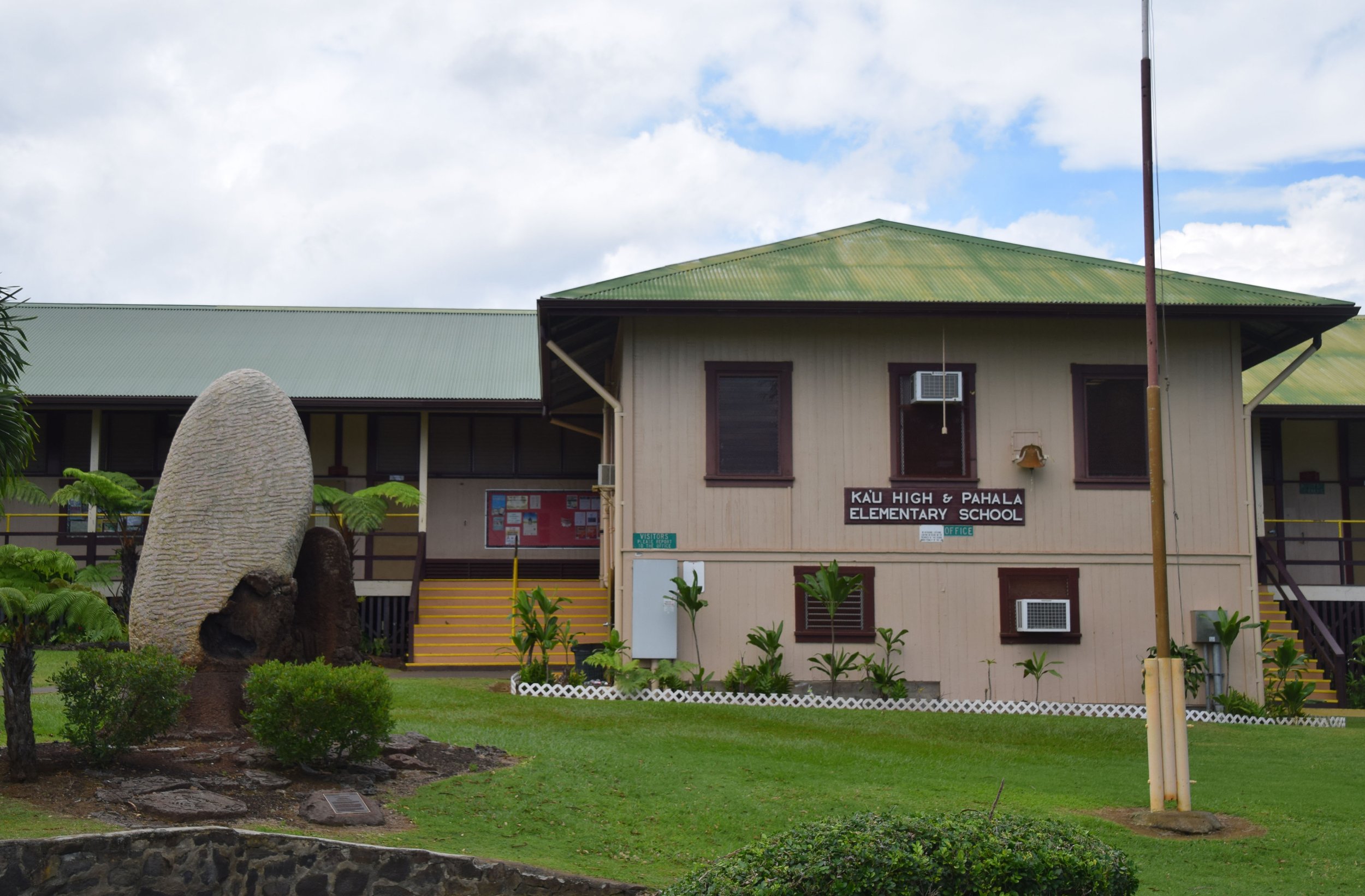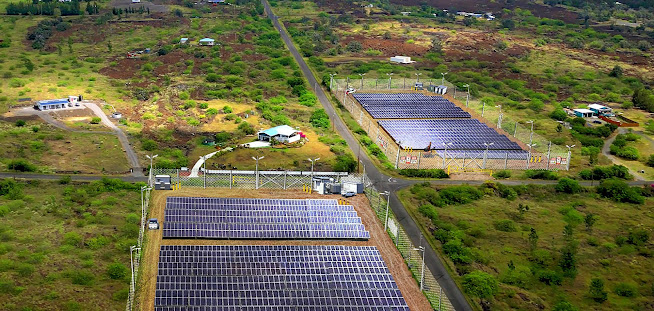An artist's rendering of how two of the proposed solar farms would look from a drone if they were to be built as planned in Ranchos. 17 such projects, each covering three acres, are planned to be built among existing homes throughout the west side
of the subdivision. The rendering is by John Fretz, a graphic artist who lives in Ranchos.
PUC STILL CONSIDERS APPROVING INDUSTRIAL SOLAR IN OV NEIGHBORHOODS. The eight-year-long fight over the proposed construction of an industrial-scale solar power generating facility in Ocean View took a new twist in October when a state Public Utilities Commission Hearings Officer released a draft of his report. It recommends that the solar project be allowed and that the PUC decide if the project is "in the public interest."
The project would allow 17 three-acre houselots to be fenced in and covered with solar panels. They would be built on lots intended for housing. The energy produced would be sold to Hawaiian Electric at 25c per kWh - nearly triple the current market price. Homes could be adjacent to industrial solar lots stripped of trees and bulldozed.
The complaint was filed with the Public Utilities Commission in August 2016 by Peter and Annie Bosted, who live in Hawaiian Ocean View Ranchos, below Highwy 11. Many home and lot owners there
joined to launch an opposition, which is documented by a petition, public testimony at community meetings and numerous letters to the PUC. Opponents contend that the solar would come with a high price for the electricity sold to Hawaiian Electric, and with degradation of family neighborhoods that would be turned into a mix of housing and industrial.
"I find it mind-boggling" is the recent comment by Ranchos resident Bob Werner. "I have been following this case since it began." He said the recent PUC report "is based on a truly shocking and disturbing misunderstanding of the complaint. Many important points have been ignored, twisted, or apparently misunderstood.
"Over a year ago the Bosteds filed follow-up briefs, amounting to about 40 pages, which detailed the case complete with evidence, citations, rules of law and everything necessary for the commission to come to a well reasoned decision," said Werner. "Now, by law, the Bosteds have less than two weeks to file 'exceptions' and ask for them to be corrected; this after it has been in the hands of the Commission for over a year. For them it will be like picking up the pieces of Humpty Dumpty and gluing the case back together again with more documentation. The way it has been completely changed is staggering and responding to all the misinterpretations and faulty reasoning will be extremely difficult in such a short time."
Werner, a retired elected county evaluator, also said, "The Hearings Officer complains that he was given a very narrow task and that many issues were outside his scope." The Hearings Officer is recommending that the Commission definitively determine whether such projects as the one proposed at Ocean View are in the public interest.
Last year the Hawai'i Supreme Court addressed proposed solar projects conceived years ago that don't necessarily result in a lower price for electricity and are far behind the current approach to alternative energy. The Court stated that, with regard to energy projects conceived decades ago, "yesterday's good enough has become today's unacceptable" and named numerous factors not in the public interest. The Court added, "The PUC was under no obligation to evaluate an energy project conceived of in 2012 the same way in 2022. Indeed, doing so would have betrayed its constitutional duty."
Solar projects now coming on line near Waikoloa sell electricity to HE for about 9c per kWh and they have backup batteries. Since the Ocean View project will not have batteries, it will supply power only when the sun is shining and will be paid 25c per kWh.
 |
An Alumni Scholarship Endowment for Kaʻū High graduates is
being created through University of Hawai'i Foundation. |
A PĀHALA-KAʻŪ
HIGH SCHOOL ALUMNI SCHOLARSHIP ENDOWMENT AT UNIVERSITY OF HAWAI'I AT HILO is in the making. Gary Ota, a 1966 graduate of Kaʻū High School, assisted in making the arrangement with University of Hawaii Foundation. He reports that so far, $26,000 of $50,000 to start funding the endowment has been raised. Once the $50,000 goal is reached, scholarships will be made available to Kaʻū High School graduates for perpetuity.
Ota notes that due to the relatively large Federal standard deduction amounts, and the increased Hawaii standard deduction amounts, donors may not receive any tax benefit by deducting contributions on tax returns. The threshold for states other than Hawai'i may vary.
Donors older than 70 ½, with an IRA, may consider making a Qualified Charitable Distribution (QCD) from the IRA. QCDs may not be made from other types of retirement accounts (e.g. 401k, 403b, TSP, etc.)
Those younger than 70 ½ and those without an IRA, could receive the benefit of QCD by partnering. Ota said that for a minimum $150, he will make a $200 QCD from his IRA for the donor. Or, a 25% "discount" on any larger amount. If interested, contact Ota at 808-622-2900.
For those 73 and older, and subject IRA Required Minimum Distribution (RMD) requirements, a QCD can be applied toward the RMD.
To avoid tax on capital gains, donors may also consider contributing stocks, ETFs, or mutual funds which have significantly appreciated in value since their purchase, said Ota who can be contacted for details.
Checks for the scholarship endowment can be made out to University of Hawaii Foundation and mailed to P.O. Box 11270, Honolulu HI 96828-0270
.HEIC) |
Letters to Santa organizer for many years, Jana Kaniho, has passed the torch to Marlene Freitas, who
will host the gift giving program at her Ku'u Ihi Flowers & Gifts next to Pāhala Post Office.
Photo by Julia Neal |
LETTERS TO SANTA KICKS OFF NOV. 1 IN PĀHALA. This years' Letters to Santa will be hosted and sponsored by Ku'u Ihi Flowers & Gifts next to Pāhala Post Office in the Pāhala Center. Co-sponsors are R & G Mini Mart and 'O Ka'ū Kākou.
Letters to Santa Pāhala, in which keiki ask Santa for gifts, will be accepted Nov. 1 through Dec. 1.
Children or parents may pick up the letter templates from Ku'u Ihi Flowers & Gifts or R & G Mini Mart. Completed letters can be dropped off in the Letters to Santa Mail Box located at Ku'u Ihi Flowers & Gifts located in the Pāhala Center.
"We will be seeking donations to help make this event a success," said organizer Marlene Freitas. For more information on how to make a donation or how donations will be used, contact Freitas at 808-987-2578.
Freitas also wished, "A huge Mahalo to Jana Kaniho for organizing the Letters To Santa event in the past years."



.jpg)
.jpg)

.HEIC)
.jpg)
.jpg)


.jpg)
.jpg)







.heic)

.jpg)

.jpg)

.jpg)


.jpg)

.png)

.HEIC)